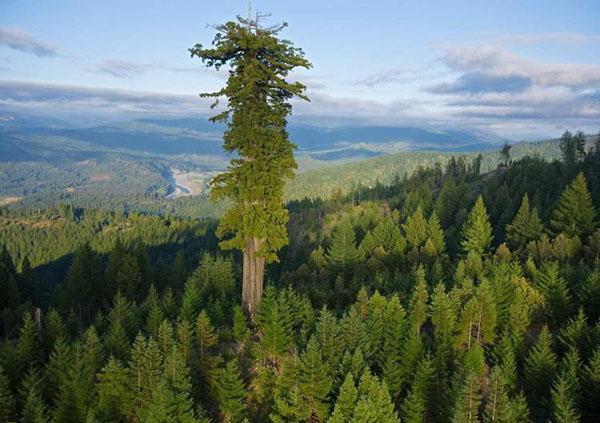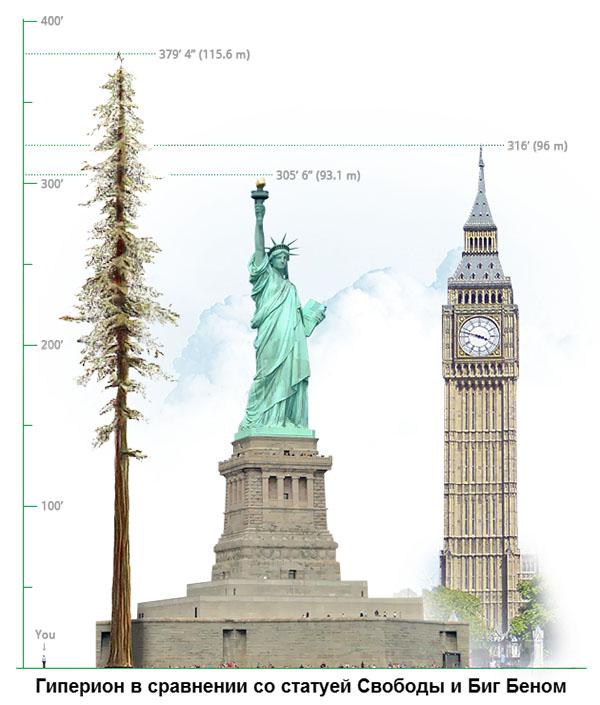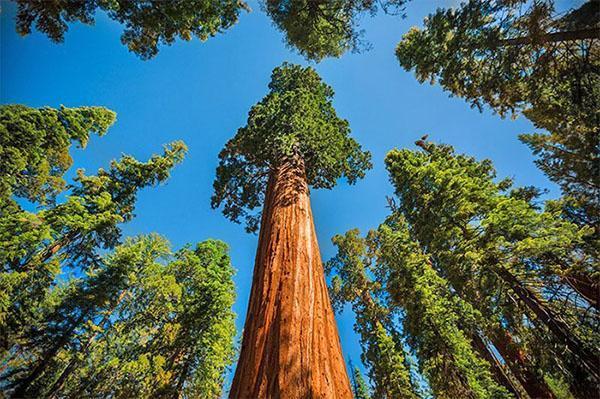The majestic sequoia tree conquers everyone with its pomp
 The sequoia tree is a phenomenon of the modern plant world. This is an example of not only overall dimensions, but also the desired longevity by everyone. The oldest representative of this genus flaunts on the territory of the Rerwood Nature Reserve in California. Although it is more than 4 millennia old, it still continues to grow rapidly. The volume of the trunk of this majestic giant is 1.5 m³, and the height is 115.5 m.
The sequoia tree is a phenomenon of the modern plant world. This is an example of not only overall dimensions, but also the desired longevity by everyone. The oldest representative of this genus flaunts on the territory of the Rerwood Nature Reserve in California. Although it is more than 4 millennia old, it still continues to grow rapidly. The volume of the trunk of this majestic giant is 1.5 m³, and the height is 115.5 m.
Historical summary
 The trees got their name not due to their external characteristics and considerable age. At one time, these lands were home to the Cherokee Indian tribe. Fascinated by the height of the sequoia tree, as well as the wonderful talents and qualities of their leader, they decided to name it after their leader. Since he really did a lot for the culture and education of his people, the public accepted this name with pleasure.
The trees got their name not due to their external characteristics and considerable age. At one time, these lands were home to the Cherokee Indian tribe. Fascinated by the height of the sequoia tree, as well as the wonderful talents and qualities of their leader, they decided to name it after their leader. Since he really did a lot for the culture and education of his people, the public accepted this name with pleasure.
Studying this "slender beauty" in 1859, one botanist decided to name her after the national hero of America. The loud name Wellington - the English general who defeated the Napoleonic army - did not like the locals. Therefore, they chose another leader and popular favorite of the Indians.
Features of sequoia
 A characteristic feature of these representatives of the class of conifers is the structure of their trunk and the method of reproduction. When the tree is still young, it is completely covered with dense branches. Due to too rapid growth, these processes do not have time to take root, so they soon disappear. As a result, an unusually thick, but at the same time completely naked, trunk appears before a curious observer.
A characteristic feature of these representatives of the class of conifers is the structure of their trunk and the method of reproduction. When the tree is still young, it is completely covered with dense branches. Due to too rapid growth, these processes do not have time to take root, so they soon disappear. As a result, an unusually thick, but at the same time completely naked, trunk appears before a curious observer.  Raising his eyes to the sky, a person can contemplate the dense crown of a conical shape, consisting of evergreen branches.
Raising his eyes to the sky, a person can contemplate the dense crown of a conical shape, consisting of evergreen branches.
It is noteworthy that the root system of such a phenomenon of the plant kingdom is not planted very deeply. However, it occupies a significant area, which allows the rock to withstand gusty winds and hurricanes.
It is regrettable, but with its root processes, it drowns out the vital activity of neighboring inhabitants. Nevertheless, its "neighborhood" can withstand:
- hemlock;
- cypress;
- douglasia (pine family);
- spruce;
- fir.
 It fits perfectly into the local color of the pine groves. The length of flat, elongated leaves ranges from 15 to 25 mm in young animals. Over time, the needles change their shape. In the shady parts of the crown, they take the form of an arrowhead, and in the upper zones the leaves have a scaly structure.
It fits perfectly into the local color of the pine groves. The length of flat, elongated leaves ranges from 15 to 25 mm in young animals. Over time, the needles change their shape. In the shady parts of the crown, they take the form of an arrowhead, and in the upper zones the leaves have a scaly structure.
It is appropriate to supplement such a description of the sequoia tree with unforgettable photos taken by tourists. The most daring of them were able to capture the exquisite cones of the "inaccessible" inhabitant of the misty gorge. Three centimeter oval capsules contain up to 7 seeds, which ripen for almost 9 months. As soon as the fruit begins to dry out, the bud opens and the seeds are carried away by the wind. Such opened “roses” adorn the majestic crown for a long time.
As soon as the fruit begins to dry out, the bud opens and the seeds are carried away by the wind. Such opened “roses” adorn the majestic crown for a long time.
Scientists are amazed by the unique way of "procreation" of the mammoth tree (this is the second name, because its branches resemble the tusks of these animals). Green sprouts grow from the stump, which is quite abnormal for the class of conifers.
The native land of the giant
 The main habitat where the sequoia tree grows is the Pacific coast of North America. The territory of their homelands stretches 75 km inland and stretches for almost 800 km along the ocean.A relatively small area of land rises 700-1000 m above sea level. Although these conifers get along well even at an altitude of more than 2 km. The more humid the climate, the higher and greener the crown of these giants will be.
The main habitat where the sequoia tree grows is the Pacific coast of North America. The territory of their homelands stretches 75 km inland and stretches for almost 800 km along the ocean.A relatively small area of land rises 700-1000 m above sea level. Although these conifers get along well even at an altitude of more than 2 km. The more humid the climate, the higher and greener the crown of these giants will be.
 The state of California and Oregon annually welcomes thousands of tourists who want to admire these beauties. In addition to natural habitats, such "long-livers" can be found on the territory of reserves:
The state of California and Oregon annually welcomes thousands of tourists who want to admire these beauties. In addition to natural habitats, such "long-livers" can be found on the territory of reserves:
- SOUTH AFRICA;
- Canada;
- Italy;
- Hawaiian Islands;
- England;
- New Zealand.
The main feature of all these countries is access to a humid maritime climate. However, such gigantic exhibits can perfectly withstand sudden changes in temperature. It was recorded that on the mountain slopes, where they can often be found, it can be up to -25 ° C. Therefore, the mammoth tree can be successfully grown on other continents. The only thing is that they grow there several times slower. And only after half a century will you be able to see the result of your hard work.
In Russia, the sequoia tree grows in the coastal regions of the Krasnodar Territory. The Sochi Arboretum has a modest "collection" of young seedlings. This section, of course, is not very large. Perhaps several centuries will pass, and a new generation of tourists will admire these luxurious Pacific "titans".  At the foot of such giants, you can feel all your insignificance. Especially when you are surrounded by a whole grove of 90-meter giants (almost 35 floors of a skyscraper). According to one study, in the early 1900s, a sequoia tree was felled, which was over 116 meters high. One can only imagine how much labor and effort it took those workers.
At the foot of such giants, you can feel all your insignificance. Especially when you are surrounded by a whole grove of 90-meter giants (almost 35 floors of a skyscraper). According to one study, in the early 1900s, a sequoia tree was felled, which was over 116 meters high. One can only imagine how much labor and effort it took those workers.
The maximum thickness of the bark of the largest tree in the world can be about 30 cm.
Wood value
 In the United States, cutting down the sequoia is severely punishable by law as the tree is threatened with extinction. Due to the slightly reddish shade of wood, it is used as interior decoration elements. Since the wood fibers of this coniferous species are quite dense, and also resistant to the decay process, they serve as an amazing material for furniture production. They also make from it:
In the United States, cutting down the sequoia is severely punishable by law as the tree is threatened with extinction. Due to the slightly reddish shade of wood, it is used as interior decoration elements. Since the wood fibers of this coniferous species are quite dense, and also resistant to the decay process, they serve as an amazing material for furniture production. They also make from it:
- paper;
- railway cars and sleepers;
- roofing elements;
- structures for underwater structures.
This raw material differs from all others in the absence of a rich coniferous smell. Therefore, many tobacco companies use sequoia to produce boxes that contain cigars and other products of the industry. Moreover, beekeepers have also found use for barrels made of expensive wood. They perfectly store honey, bee bread, and wax.
 According to the calculations of the processing enterprise, more than one thousand tons of raw wood can be obtained from one mammoth tree. To transport all this wealth, the customer will need over fifty wagons, that is, almost a whole freight train.
According to the calculations of the processing enterprise, more than one thousand tons of raw wood can be obtained from one mammoth tree. To transport all this wealth, the customer will need over fifty wagons, that is, almost a whole freight train.
In the trunk of a luxurious giant, all kinds of pests / parasites rarely settle. This is due to the rapid growth of the plant. Also, the wood of the mammoth tree contains a huge amount of phytoncides. These biologically active substances are able not only to "scare away" huge "hordes" of harmful insects, but also to keep them at a decent distance.
 It is noteworthy that in the reserves every fallen sequoia tree has a place of honor. From its trunk, amazing exhibits are made that impress tourists. So, one enterprising American made a parking space in it, and in another case, he equipped a cozy restaurant for 50 people. Creative ideas were borrowed by the Sequoia National Park. It is here that tourists will be able to drive through an unusual tunnel made of a fallen tree. Yes, nature is striking in its diversity and magnificent beauty.
It is noteworthy that in the reserves every fallen sequoia tree has a place of honor. From its trunk, amazing exhibits are made that impress tourists. So, one enterprising American made a parking space in it, and in another case, he equipped a cozy restaurant for 50 people. Creative ideas were borrowed by the Sequoia National Park. It is here that tourists will be able to drive through an unusual tunnel made of a fallen tree. Yes, nature is striking in its diversity and magnificent beauty.